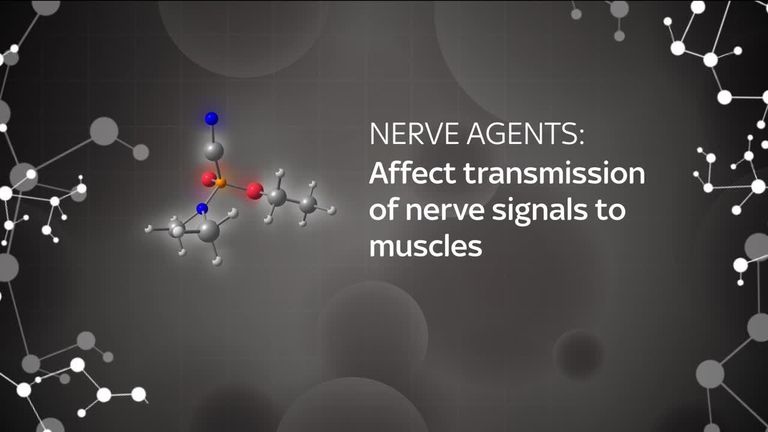What is a nerve agent and how does it work?
As hundreds of detectives investigate the Salisbury poisoning, we take a closer look at the science behind the lethal toxins.
Thursday 8 March 2018 11:46, UK
The poisoning of ex-Russian spy Sergei Skripal and his daughter Yulia is being treated as attempted murder by nerve agent.
As hundreds of detectives, forensic officers and analysts urgently investigate the cause of their illness, we take a closer look at the science behind the lethal toxins.
What is a nerve agent?
A nerve agent works by interrupting the messaging from the brain down into the muscles.
Sky News Science and Medical Correspondent Thomas Moore says: "The muscles become paralysed and if the breathing muscles are affected victims can die by asphyxiation."
What are the symptoms?
The victims of this suspected poisoning had difficulty breathing, and were described by witnesses as "wheezing".
They were discovered unconscious on a park bench in Salisbury Maltings shopping centre vomiting, twitching and "slumped" together.
Thomas Moore says further symptoms of nerve agent can include: "Confusion and an abnormal heart beat. They can start within minutes or hours, depending on how long the victim was exposed to the chemical and the method of administration."
The two victims remain in a critical condition in quarantine in hospital.
How was the agent administered?
There are a number of options as to how the poison could have been administered. Thomas Moore says "generally speaking it is a liquid hazard, to turn it into a gas you need heat. That doesn't seem likely in this instance".
Putting the liquid into a spray so it enters the body through the eyes or skin can be a very speedy way to administer the poison, and can lead to instant death.
Secreting the liquid into a drink or into food are also possibilities, but would tend to have a slower effect than direct skin contact.
What was the substance used to poison them?
There are many different types of nerve agent. Here are some of the most well-known:
:: VX nerve agent
VX is an extremely toxic chemical compound that was originally developed for military use.
Just 10 milligrams of VX, when absorbed through the skin, is enough to cause "fatal disruption of the nervous system" within 15 minutes.
It is a clear, colourless liquid which is hard to detect.
VX penetrates the skin and disrupts the transmission of nerve impulses. Those exposed to the agent experience convulsions, loss of consciousness, paralysis and fatal respiratory failure.
It is believed to have been the substance used to assassinate Kim Jong Un's half-brother Kim Jong Nam at the airport in Kuala Lumpur, Malaysia, on 13 February last year.
:: Sarin
Sarin can turn your own body against you - and exposure has the potential to kill you within minutes.
The brain uses neurotransmitters which tell your body what to do. Once they have done their job, they are usually destroyed by enzymes.
Sarin gas stops the enzymes from doing this, which means the neurotransmitters keep delivering these messages. In effect, it means you lose control of your body - sending it into overdrive.
Symptoms include convulsions, dilated pupils, vomiting, tightening of the chest and an uncontrollable bladder.
This chemical weapon, like many others, was made illegal by the United Nations in 1997.
:: Soman
Soman is an extremely toxic chemical liquid that is clear and colourless - although it goes yellow to brown as it ages - and gives off a vapour.
Its smell has been described as similar to camphor or rotting fruit. It can be spread like an aerosol spray, or used to contaminate food or water.
Soman prevents the nervous system functioning properly. It causes pain in the eyes, nausea, vomiting, abdominal pain, shortness of breath, muscle twitching and loss of consciousness.
It can kill quickly. If they do survive, research has shown a victim of Soman is likely to experience long-term psychological effects.
The UN has classified Soman as a weapon of mass destruction.
::Thallium
This heavy metal poison is colourless, odourless and tateless.
It is used commercially as a metal element in electronics, the pharmaceutical industry and in glass manufacturing. It is also used in infrared detectors.
Known as the "poisoner's poison", it can be used in liquid form or in a powder to poison the victim.
Historically used as a rat poison, its non-selective toxicity led to bans of the compound in the majority of countries.
It is slow acting and painful, with an additional side-effect of hair loss.
It is notoriously hard to trace.
:: Organic phosphate pesticides
Organophosphate pesticides can cause similar symptoms and work in a similar way to nerve agents.
These chemical compounds of phosphoric acid make up about 50% of the killing agents in chemical pesticides.
After World War II large quantities were made and marketed as insecticides.
Like nerve agents, they affect the brain's neurotransmitters and can cause disorientation, headaches and influenza-like symptoms.
Treatment for nerve agents
An antidote would need to be given to victims as soon as possible, in order to minimise any further damage to the muscles.
Thomas Moore says: "It may now be matter of supporting the patients and helping them breathe, hoping that their bodies can recover themselves."
Professor Alastair Hay, an environmental toxicologist at Leeds University told Sky News: "I am very pleased they have been able to identify a family of chemicals because this will be very helpful to the doctors looking after the individuals who have been affected.
"They have now got some guidance on what to do because there are some very specific treatment protocols when individuals are exposed to nerve agents."
What is the risk to the public?
Chief Medical Officer Dame Sally Davies said the event posed "a low risk" to the public, and that "all the sites that the patients were known to have visited have been secured so the public are protected".
A business park in Amesbury, the bench where the victims were found in Salisbury, a Zizzi restaurant and a nearby pub called The Bishop's Mill have now all been cordoned off by police.
Evidence is now being gathered, as police seek to establish the specific substance used and the agents behind the attack.



![鈥疨ic: CPS
Images of two defendants in fake ID seized from Bulgarian gang found guilty of spying for Russia in a huge espionage operation from a guesthouse in Great Yarmouth. Left is Katrin Ivanova, [DOB: 01/07/1991], is of Harrow, north-west London. Right is Tihomir Ivanchev, [DOB: 31/07/1985], is of Acton, west London](https://e3.365dm.com/25/03/192x108/AG百家乐在线官网news-katrin-ivanova-tihomir-ivanchev_6849259.png?20250307175120)










